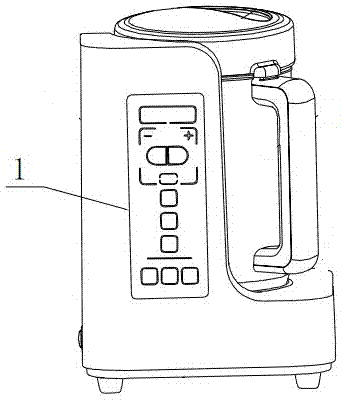Self-adjusting intelligent kitchen household appliance
A smart kitchen, self-adjusting technology, applied in the direction of electrical program control, control/adjustment system, instrument, etc., to achieve the effect of convenient service, cost saving, convenient and convenient operation
- Summary
- Abstract
- Description
- Claims
- Application Information
AI Technical Summary
Problems solved by technology
Method used
Image
Examples
Embodiment 1
[0025] A self-adjustable smart kitchen appliance of the present invention, the home appliance includes a function operation display device, a controller and a function load execution device, the function operation display device and the function load execution device are respectively electrically connected to the controller, wherein, The function operation display device includes a function display icon, the function display icon corresponds to a function, and the controller sorts the positions of the function display icons according to the frequency of use of the function.
[0026] Such as figure 1 As shown, in this embodiment, the function operation display device is an electronic touch screen 1, and the function operation selection of the home appliance is realized by touching the function display icon. That is, the electronic touch screen is provided on the home appliance, and the electronic touch screen is provided with function display icons. When a user needs to select ...
Embodiment 2
[0031] The difference between this embodiment and the above-mentioned embodiment 1 is that when calculating the frequency of use of a function, the controller not only accumulates the number of times of use of the function by superposition, but also sets different proportion weights for the number of times of use in different time periods. In order to calculate the frequency of function usage better and more intelligently.
[0032] In this embodiment, weights can be set by year, quarter, month, week, etc. The frequency of function usage within one week accounts for 80% of the overall frequency of use, and the frequency of function usage within one month accounts for 80% of the overall frequency of use. The proportion weight of the function usage frequency in the first quarter is 5% of the overall usage frequency, and the proportion weight of the function usage frequency in one year is 5% in the overall usage frequency. The frequency of use does not enter into the calculation r...
Embodiment 3
[0035] The difference between this embodiment and the above 1 is that the program corresponding to the function is provided with a function use trigger condition, and when the function is executed up to the function use trigger condition, it is considered that the corresponding function is used once.
[0036] To prevent the user from performing an operation, after the function selection is incorrectly modified, the previously selected function will be recorded and used once, which will cause deviations in the final statistical function usage frequency. In this embodiment, the trigger condition is that the program of the function executes the last step, that is, the home appliance triggers the controller to record a function use after the function creation has been completed.
[0037] Of course, the trigger condition can also be set as a certain process in the function execution process, such as the collision and anti-overflow of the soymilk function in the soymilk machine as th...
PUM
 Login to View More
Login to View More Abstract
Description
Claims
Application Information
 Login to View More
Login to View More - R&D
- Intellectual Property
- Life Sciences
- Materials
- Tech Scout
- Unparalleled Data Quality
- Higher Quality Content
- 60% Fewer Hallucinations
Browse by: Latest US Patents, China's latest patents, Technical Efficacy Thesaurus, Application Domain, Technology Topic, Popular Technical Reports.
© 2025 PatSnap. All rights reserved.Legal|Privacy policy|Modern Slavery Act Transparency Statement|Sitemap|About US| Contact US: help@patsnap.com

